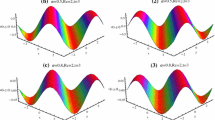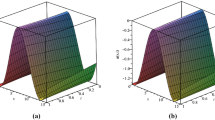Abstract
In this work, we concentrate on the analysis of the time-fractional Rosenau–Hyman equation occurring in the formation of patterns in liquid drops via q-homotopy analysis transform technique and reduced differential transform approach. The q-homotopy analysis transform algorithm can provide rapid convergent series by choosing the appropriate values of auxiliary parameters ħ and n at large domain. The reduced differential transform technique gives wider applicability due to reduction in computations and makes the calculation much simpler and easier. The proposed techniques are realistic and free from any assumption and perturbation for solving the time-fractional Rosenau–Hyman equation.



Similar content being viewed by others
Explore related subjects
Discover the latest articles, news and stories from top researchers in related subjects.References
Atangana A, Alabaraoye E (2013) Solving a system of fractional partial differential equations arising in the model of HIV infection of CD4+ cells and attractor one-dimensional Keller–Segel equations. Adv Differ Equ. doi:10.1186/1687-1847-2013-94
Rivero M, Trujillo J, Vazquez L, Velasco M (2011) Fractional dynamics of populations. Appl Math Comput 218:1089–1095
Chen Y, An YH (2009) Numerical solutions of coupled Burgers equations with time and space fractional derivatives. Appl Math Comput 200:87–95
Su X (2009) Boundary value problem for a coupled system of nonlinear fractional differential equations. Appl Math Lett 22:64–69
Jafari H, Tajadodi H (2015) Numerical solution of the fractional advection-dispersion equation. Progr Fract Differ Appl 1:37–45
Rao SB, Prajapati JC, Patel AD, Shukla AK (2014) Some properties of Wright-type generalized hypergeometric function via fractional calculus. Adv Differ Equ. doi:10.1186/1687-1847-2014-119
Zhang S (2009) Monotone iterative method for initial value problem involving Riemann–Liouville fractional derivatives. Nonlinear Anal 71:2087–2093
Kumar D, Singh J, Baleanu D (2016) Numerical computation of a fractional model of differential-difference equation. J Comput Nonlin Dyn 11(6):061004. doi:10.1115/1.4033899
Oldham KB, Spanier J (1974) The fractional calculus: integrations and differentiations of arbitrary order. Academic Press, New York
Caputo M (1967) Linear models of dissipation whose Q is almost frequency independent. Part II. J R Astron Soc 13:529–539
Samko SG, Kilbas AA, Marichev OI (1993) Fractional integrals and derivatives: theory and applications. Gordon and Breach, London
Carpinteri A, Mainardi F (1997) Fractional calculus in continuum mechanics. Springer, New York
Podlubny I (1999) Fractional differential equations. Academic Press, San Diego
Miller KS, Ross B (1993) An introduction to the fractional calculus and fractional differential equations. Wiley, New York
Khan NA, Ara A, Mahmood A (2010) Approximate solution of time fractional chemical engineering equations: a comparative study. Int J Chem React Eng. doi:10.2202/1542-6580.2156
Maraaba TA, Jarad F, Baleanu D (2008) On the existence and the uniqueness theorem for fractional differential equations with bounded delay within Caputo derivatives. Sci China Ser A Math 51:1775–1786
Rosenau P, Hyman JM (1993) Compactons: solitons with finite wavelength. Phys Rev Lett 70:564–567
Mihaila B, Cardenas A, Cooper F, Saxena A (2010) Stability and dynamical properties of Rosenau–Hyman compactons using Padè approximants. Phys Rev E. doi:10.1103/PhysRevE.81.056708
Bazeia D, Das A, Losano L, Santos MJ (2010) Traveling wave solutions of nonlinear partial differential equations. Appl Math Lett 23:681–686
Rus F, Villatoro FR (2007) Self-similar radiation from numerical Rosenau–Hyman compactons. J Comput Phys 227:440–454
Rus F, Villatoro FR (2007) Padè numerical method for the Rosenau–Hyman compacton equation. Math Comput Simul 76:188–192
Rus F, Villatoro FR (2009) A repository of equations with cosine/sine compactons. Appl Math Comput 215:1838–1851
Rus F, Villatoro FR (2008) Numerical methods based on modified equations for nonlinear evolution equations with compactons. Appl Math Comput 204:416–422
Molliq RY, Noorani MSM (2012) Solving the fractional Rosenau–Hyman equation via variational iteration method and homotopy perturbation method. Int J Differ Equ 2012. Article ID 472030
El-Tawil MA, Huseen SN (2012) The q-homotopy analysis method (q- HAM). Int J Appl Math Mech 8:51–75
El-Tawil MA, Huseen SN (2013) On convergence of the q-homotopy analysis method. Int J Contemp Math Sci 8:481–497
Liao SJ (1992) The proposed homotopy analysis technique for the solution of nonlinear problems. Ph.D. Thesis, Shanghai Jiao Tong University
Liao SJ (2003) Beyond perturbation: introduction to the homotopy analysis method. Chaoman and Hall/CRC Press, Boca Raton
He JH (1999) Homotopy perturbation technique. Comput Methods Appl Mech Eng 178:257–262
He JH (2003) Homotopy perturbation method: a new nonlinear analytical technique. Appl Math Comput 135:73–79
He JH (2006) New interpretation of homotopy perturbation method. Int J Mod Phys B 20:2561–2568
Khuri SA (2001) A Laplace decomposition algorithm applied to a class of nonlinear differential equations. J Appl Math 1:141–155
Khan Y, Wu Q (2011) Homotopy perturbation transform method for nonlinear equations using He’s polynomials. Comput Math Appl 61(8):1963–1967
Kumar D, Singh J, Kumar S (2015) A fractional model of Navier–Stokes equation arising in unsteady flow of a viscous fluid. J Assoc Arab Univ Basic Appl Sci 17:14–19
Kumar S, Kumar A, Kumar D, Singh J, Singh A (2015) Analytical solution of Abel integral equation arising in astrophysics via Laplace transform. J Egypt Math Soc 23(1):102–107
Khan M, Gondal MA, Hussain I, Karimi Vanani S (2012) A new comparative study between homotopy analysis transform method and homotopy perturbation transform method on semi-infinite domain. Math Comput Model 55:1143–1150
Kumar D, Singh J, Kumar S, Sushila (2014) Numerical computation of Klein-Gordon equations arising in quantum field theory by using homotopy analysis transform method. Alex Eng J 53(2):469–474
Yin XB, Kumar S, Kumar D (2015) A modified homotopy analysis method for solution of fractional wave equations. Adv Mech Eng 7(12):1–8
Keskin Y, Oturanc G (2010) Reduced differential transform method: a new approach to factional partial differential equations. Nonlinear Sci Lett A 1:61–72
Gupta PK (2011) Approximate analytical solutions of fractional Benney–Lin equation by reduced differential transform method and the homotopy perturbation method. Comput Math Appl 58:2829–2842
Srivastava VK, Awasthi MK, Tamsir M (2013) RDTM solution of Caputo time fractional-order hyperbolic telegraph equation. AIP Adv. doi:10.1063/1.4799548
Caputo M (1969) Elasticita e dissipazione. Zani-Chelli, Bologna
Kilbas AA, Srivastava HM, Trujillo JJ (2006) Theory and applications of fractional differential equations. Elsevier, Amsterdam
Clarkson PA, Mansfield EL, Priestley TJ (1997) Symmetries of a class of nonlinear third-order partial differential equations. Math Comput Modell 25(8–9):195–212
Acknowledgements
The authors are highly grateful to the referees for their invaluable suggestions and comments for the improvement of this article.
Author information
Authors and Affiliations
Corresponding author
Ethics declarations
Conflict of interest
The authors declare that there is no conflict of interests regarding the publication of this paper.
Rights and permissions
About this article
Cite this article
Singh, J., Kumar, D., Swroop, R. et al. An efficient computational approach for time-fractional Rosenau–Hyman equation. Neural Comput & Applic 30, 3063–3070 (2018). https://doi.org/10.1007/s00521-017-2909-8
Received:
Accepted:
Published:
Issue Date:
DOI: https://doi.org/10.1007/s00521-017-2909-8




